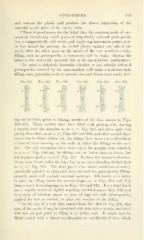Page 335 - My FlipBook
P. 335
GUTTA-PERCHA. 333
and contour the plastic and produce the chjsest adaptation of the
material to all parts of the cavity walls.
" There is good reason for the belief that the common mode of suc-
cessively introducing small pieces of imperfectly softened gutta-percha
into a com]iaratively cold cavity, and employing instrument points more
or less heated for packing the cooled })lastic against one side of the
cavity after the other, must in the nature of the case result in a leaky
filling, such as gutta-percha is connnonly said to make, whereas the
defect is due not to the material, but to its inconsiderate manipulator.
" In order to definitely determine whether or not suitably softened
gutta-percha inserted by the mass-method Avill make a moisture-tight
filling, some porcelain teeth of natural sizes and forms were made, hav-
FiG. 311. Fig. 312. Fig. 313.
d-K^- A' ^
i
A'
%^
ing cut in them, prior to baking, cavities of the class shown in Figs.
298-305. These cavities have been filled with gutta-percha, leaving
a surplus over the margins as at o, a', Fig. 310, and when quite cool
paring them flush as at A, A', Figs. 308 and 309, and after several days'
immersion in dilute aniline ink, the fillings have been removed without
a trace of color showing on the walls of either the fillings or the cavi-
ties. The only exceptions have been where the margins were rounded,
as at a, a' , Fig. 310, and the fillings not cut below them as shown, but
left feather-edged as at d, cV , Fig. 312. In these few instances discolor-
ations were found under the laps, but in no case extending farther than
to A', A', Fig. 313. The tests prove that under conditions as nearly
practically parallel as extra-oral tests can well be, gutta-percha fillings
properly made will exclude external moisture. Obviously, it is better
to pare the filling below the enamel-slo])es, as in Figs. 311 and 313,
than to leave it overlapping, as in Figs. 310 and 312. For a final finish
use a rapidly revolved, lightly touching cuttlefish-paper disk, fi)llowed
by a wisp of bibulous paper or piece of tape wet Avith chloro-percha,
applied for but an instant, to glaze the .surface of the filling.
" In the case of a very thin enamel front like that of Fig. 299, that
part of the cavity C may be varnished with thin chloro-percha and dried
with hot air just prior to filling it as before said. It might first be
thinly coated with a tinted oxyphosphatc or oxychlorid of zinc, which


